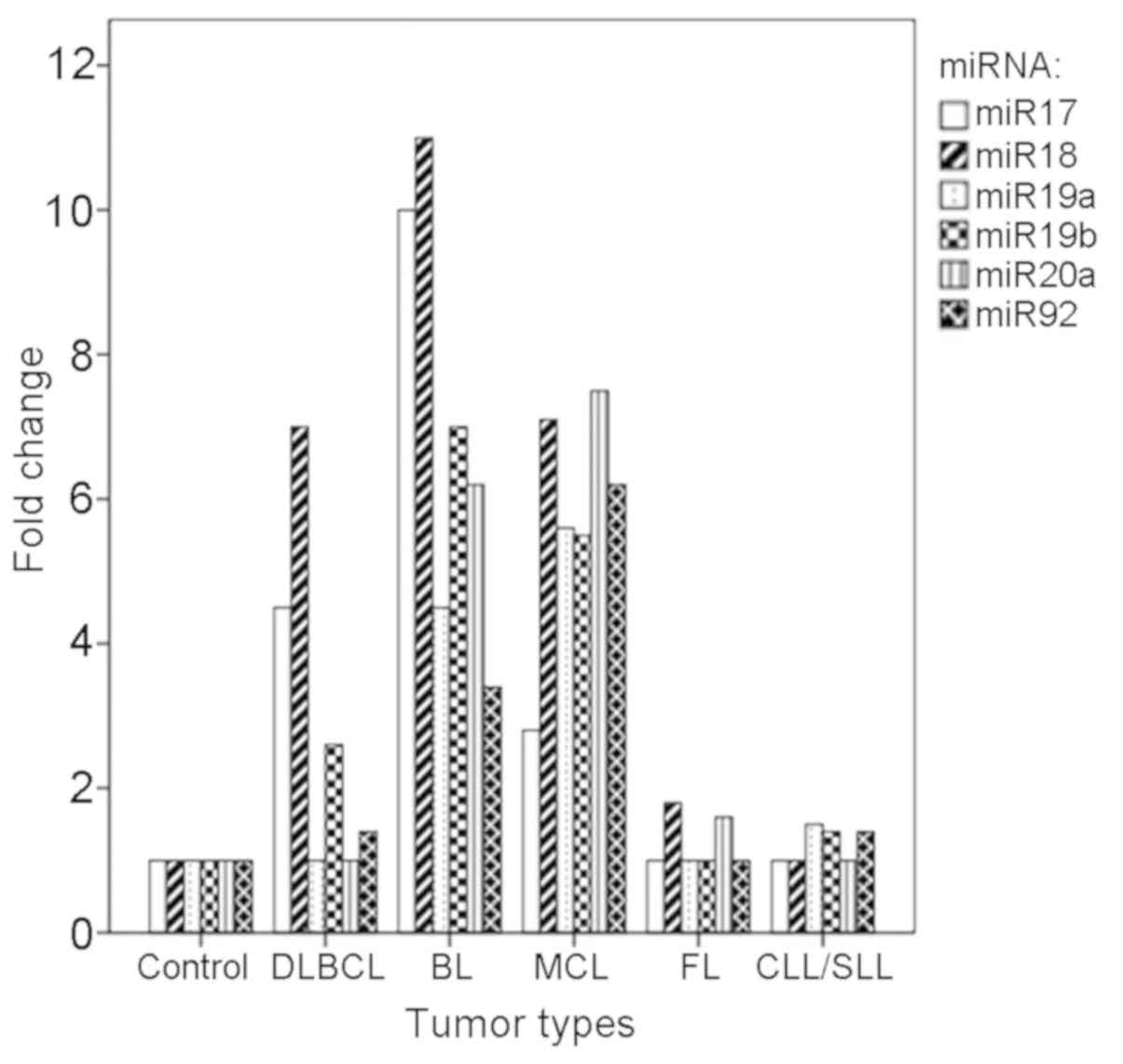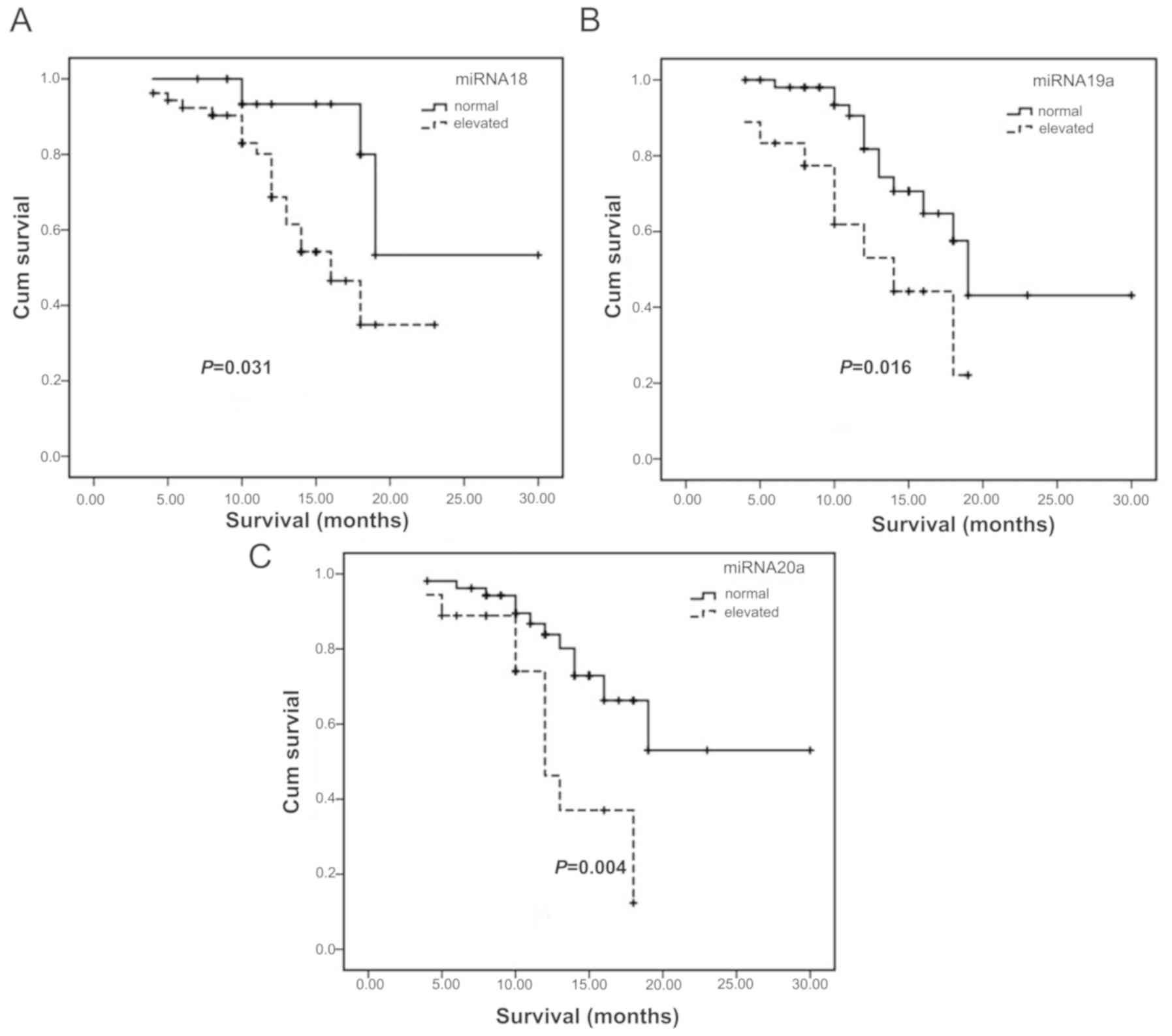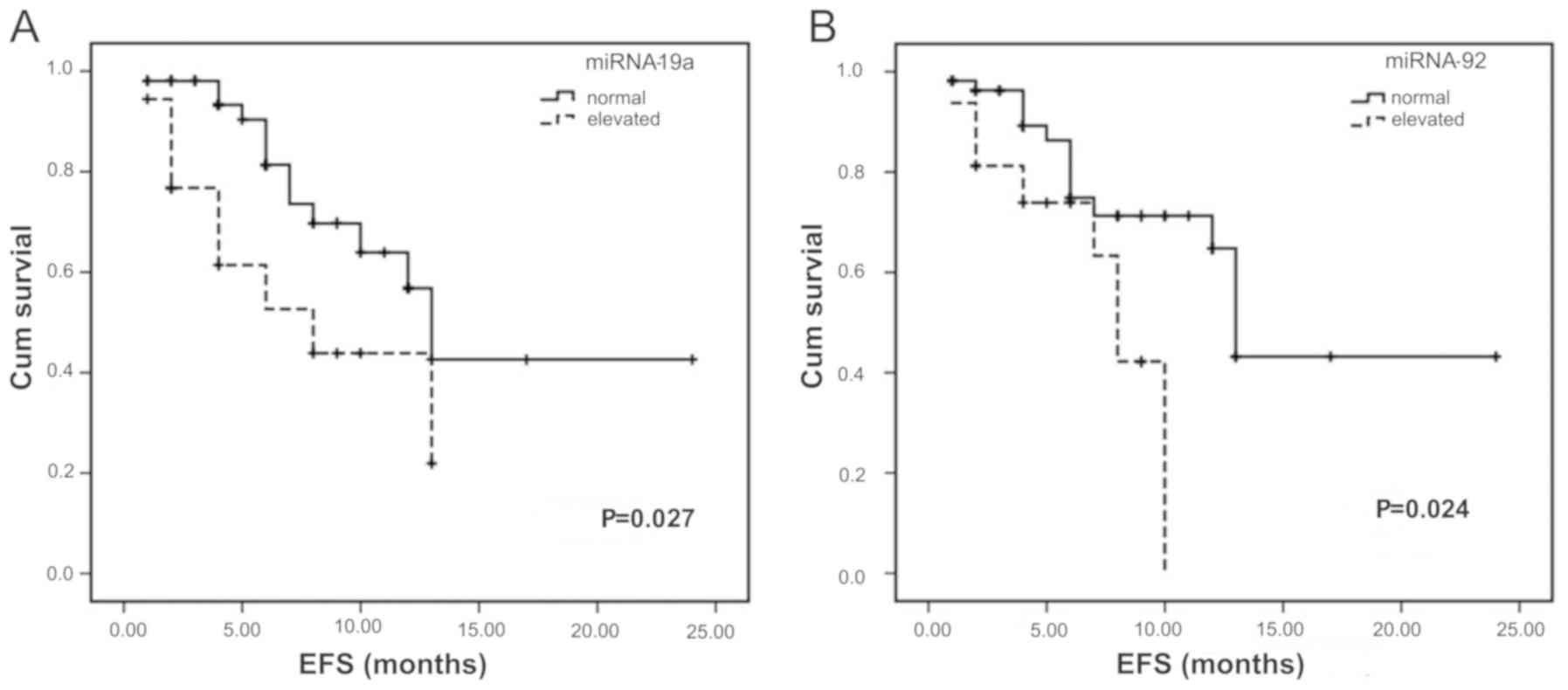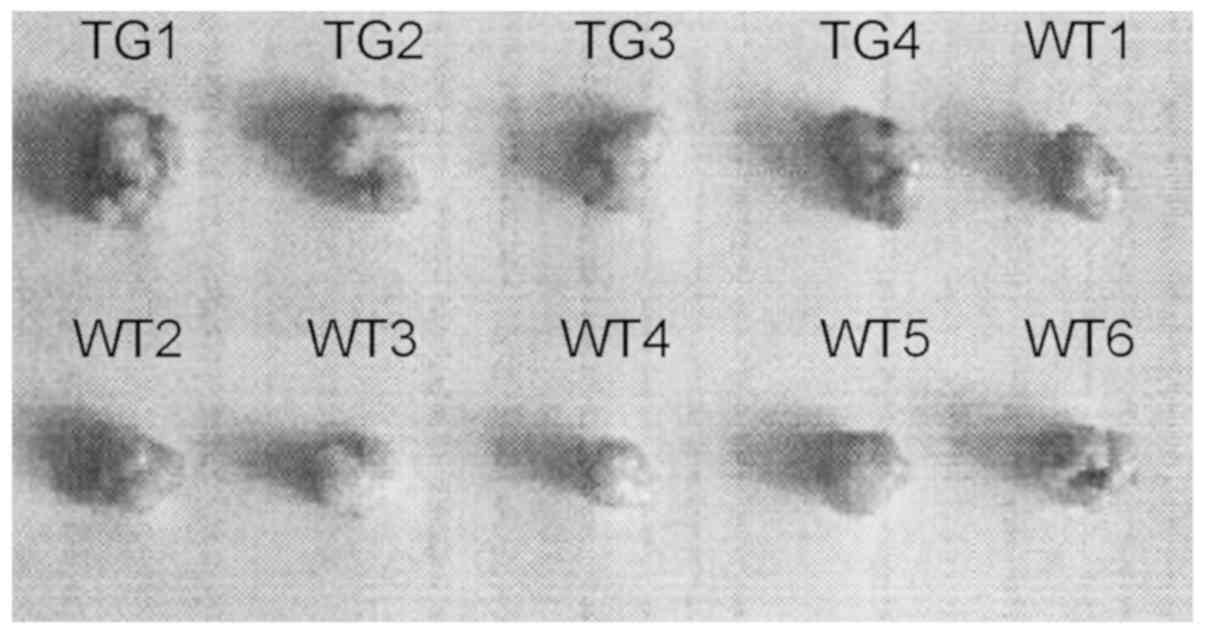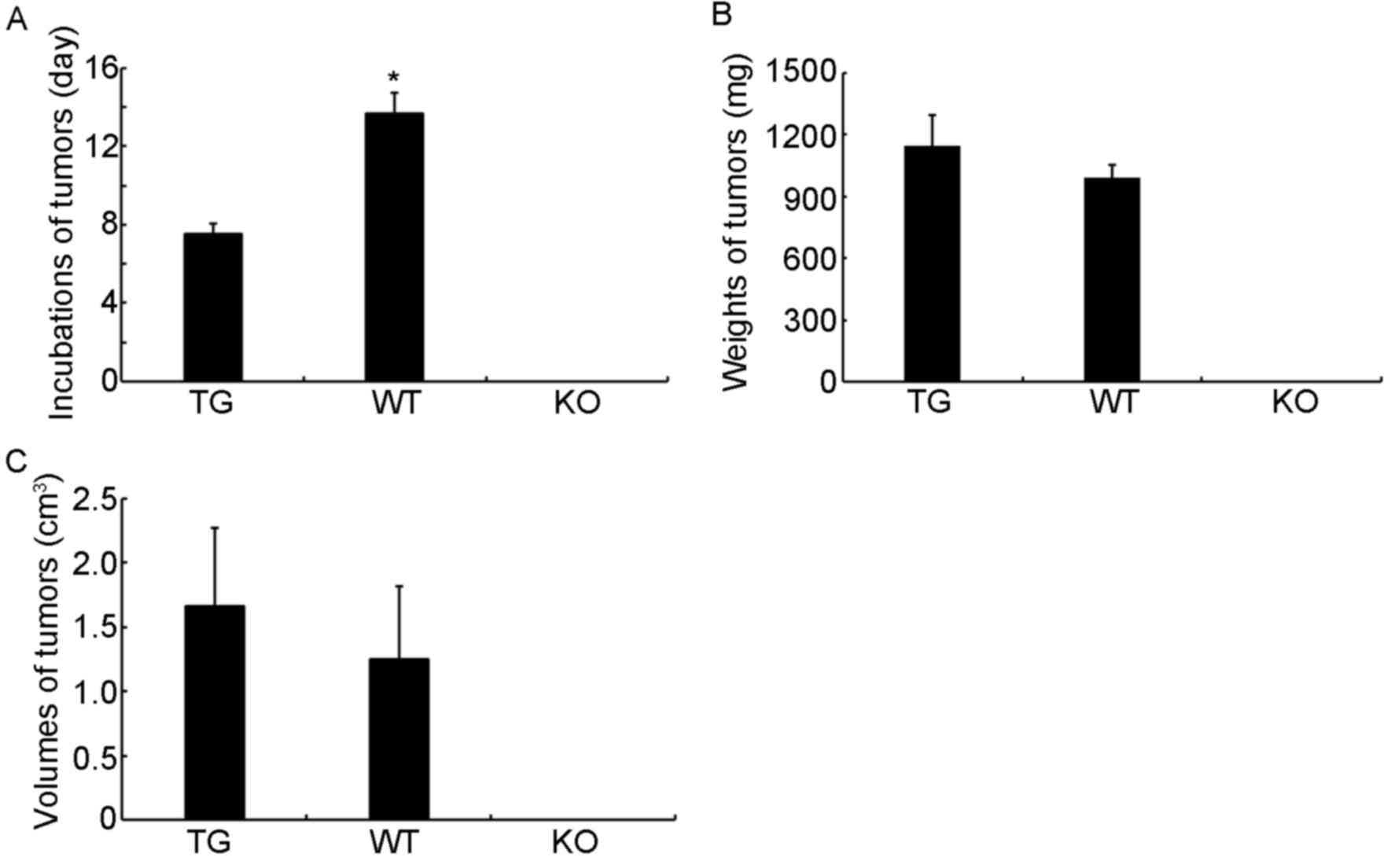Significance of the microRNA‑17‑92 gene cluster expressed in B‑cell non‑Hodgkin's lymphoma
- Authors:
- Published online on: July 1, 2019 https://doi.org/10.3892/mmr.2019.10448
- Pages: 2459-2467
Abstract
Introduction
Non-Hodgkin's lymphoma (NHL), a heterogeneous group of lymphoid-derived malignancies, is the seventh most prevalent type of cancer. According to the incidence trend, ~74,680 newly diagnosed cases and 19,910 cases of mortality were estimated to occur in 2016 in the USA (1). According to its origination, NHL can be divided into three types: B-cell origin, T-cell origin, and natural killer (NK)-cell origin (2). Among cases, ~80-90% are B-cell origin, namely B-NHL (3). Specifically, diffuse B-cell lymphoma (DLBCL), mantle cell lymphoma (MCL), follicular lymphoma (FL), chronic lymphocytic leukemia/small lymphocytic lymphoma (CLL/SLL), and Burkitt lymphoma (BL) are the most prevalent types of B-NHL (2). Although there have been multiple trials in the treatment of B-NHL, due to the diverse clinical and pathological performances, the diagnosis and prognosis of B-NHL and its underlying mechanism remain to be fully elucidated (4).
MicroRNAs (miRNAs) are a type of short, non-coding RNA molecule (18–22 nt) which are mainly known to be involved in the regulation of gene expression by binding to the 3′-untranslated regions (3′-UTR) of target mRNAs (4). In previous years, miRNAs have been found to be important in several types of cancer, including stomach (5), colon (6) and ovarian cancer (7), in addition to B-NHL (8). Previous studies have reported that aberrant high levels of miRNA (miR)-221, miR-21 and miR-155 are significant indicators of a poor prognosis of DLBCL (9–11). Akao et al (12) documented that the expression levels of miR-143 and miR-145 were downregulated in B-cell malignancies, and that increasing the expression of both induced dose-dependent growth-inhibition in BL cell lines. miR-150 and miR-16 have also been observed to have elevated expression in CLL (13,14). Taken together, this evidence indicates that miRNAs may be closely correlated with the development of B-NHL.
The miR-17-92 gene cluster is a commonly gene amplified loci in the non-protein-coding gene C13orf25 at 13q31.3 in several types of solid tumor and lymphoproliferative disorders (15,16). In this region, six tandem loop hairpin structures are contained and six mature miRNAs, including miR-17, miR-18a, miR-19a, miR-19b, miR-20a and miR-92a, are ultimately produced and involved in the regulation of cellular processes (15). The miR-17-92 cluster is also crucial in the development of B-NHL. Tagawa et al (17) documented that c-Myc can not only promote the transcription of miR-17-92 cluster, but can also act as a target of the miR-17-92 cluster. A high-level of miR-17-92 cluster expression also results in the poor survival rate of patients with MCL (18). With the exception of MCL, the miR-17-92 gene cluster is also upregulated in DLBCL and ALL, and correlated with a poorer prognosis (19–21). Together, the above evidence indicates that miR-17-92 may be crucial in B-NHL, however, the detailed expression of mature miRNA in different types of B-NHL remains to be elucidated. Therefore, the present study aimed to examine the specific expression of the miR-17-92 gene cluster in different types of B-NHL, in order to provide novel insights into the treatment and prognostic prediction of B-NHL.
Materials and methods
Patients and enrolment criteria
Between January 2012 and October 2014, 71 patients, who were first diagnosed with B-NHL in the Department of Hematology, Harbin Medical University Cancer Hospital (Harbin, China), were enrolled in the present study. The basic information of patients, including gender, age, B symptoms, clinical stage, international prognostic index (IPI) score and the level of lactic dehydrogenase, were also collected. Patients were enrolled if they met the following inclusive criteria: i) Patients were preliminary diagnosed with B-NHL; ii) the diagnostic result was confirmed by two pathologists; iii) the content of tumor cells was >80%. In addition, patients were excluded if they had other types of tumor, if the diagnostic results had no definite pathological significance, or if certain types of tumor were not confirmed. Additionally, five patients with reactive hyperplasia lymph nodes were enrolled as controls. The follow-up was ended by recurrence or the occurrence of patient mortality and the final follow-up time was June 30th, 2016. The overall survival (OS) was defined as the time from diagnosis to patient mortality from any cause, and event-free survival (EFS) was designed as the time from diagnosis to disease progression or mortality from any cause, whichever occurred first. All patients were informed and provided signed consent, and the clinical investigation was authorized by the Ethics Committee of Harbin Medical University Cancer Hospital.
Cells and culture
Primary mouse lymphoma cells of wild-type (WT), which had normal expression of the miR-17-92 gene cluster; knockout (KO), which had deficient expression of the miR-17-92 gene cluster; and TG, which had 3–4 times higher expression of the miR-17-92 gene cluster than normal, were provided by the Ron Levy Laboratory of Stanford University (Stanford, CA, USA) (22). All cell lines were maintained in RPMI-1640 medium (Gibco; Thermo Fisher Scientific, Inc., Waltham, MA, USA) containing 10% fetal bovine serum (Gibco; Thermo Fisher Scientific, Inc.) at 37°C in a humidified incubator with a 5% CO2 atmosphere.
RNA extraction
Following collection of the tumor and inflammatory tissues, signal cell suspension was produced. According to the manufacturer's protocol, total RNA of the cells was extracted using an RNA extraction kit (Omega Bio-Tek, Inc., Norcross, GA, USA). In addition, the concentration and purity of the RNA were measured using a NanoDrop Nd-1000 spectrophotometer (Thermo Fisher Scientific, Inc.).
Reverse transcription-quantitative polymerase chain reaction (RT-qPCR) analysis
Based on the concentration of RNA, the RNA in each sample was adjusted to the same concentration and a reverse transcription kit (TaqMan® MicroRNA assay; Applied Biosystems; Thermo Fisher Scientific, Inc.) was utilized to synthesize cDNA according to the manufacturer's protocol. The RT primers were designed as follows: miR-17, 5′-GTCGTATCCAGTGCGTGTCGTGGAGTCGGCAATTGCACTGGATACGACCTACCTG-3′; miR-18a, 5′-GTCGTATCCAGTGCGTGTCGTGGAGTCGGCAATTGCACTGGATACGACCTATCTG-3′; miR-20a, 5′-GTCGTATCCAGTGCGTGTCGTGGAGTCGGCAATTGCACTGGATACGACCTACCTG-3′; and U6, 5′-CGCTTCACGAATTTGCGTATCAT-3′. Subsequently, the synthesized cDNA was used as template to detect the level of the miR-17-92 gene cluster in the B-NHL and control groups via RT-qPCR analysis (Quantifier Human DNA Quantification kit, Thermo Fisher Scientific, Inc.) using the following conditions: 95°C for 10 min, and 40 cycles of 95°C for 10 min, 95°C for 15 sec, and 60°C for 31 sec. The total volume of the reaction system was 20 µl, including 1.33 µl cDNA, 10 µl 2X TaqMan® GeneExpression Master Mix, 1 µl 20X Real time Primer and 7.67 µl dH2O. U6 was set as internal control of this procedure. The primers were synthesized as follows: miR-17, sense 5′-ATCCAGTGCGTGTCGTG-3′ and antisense 5′-TGCTTAAAGTGCTTACAGTG-3′; miR-18a, sense 5′-ATCCAGTGCGTGTCGTG-3′ and antisense 5′-TGCTTAAGGTGCATCTAGTG-3′; miR20, sense 5′-ATCCAGTGCGTGTCGTG-3′ and antisense 5′-TGCTTAAAGTGCTTAATAGTG-3′; miR-17-92, sense 5′-CTGTCGCCCAATCAAACTG-3′ and antisense 5′-GTCACAATCCCCACCAAAC-3′; and U6, sense 5′-GCTTCGGCAGCACATATACTAAAAT-3′ and antisense 5′-CGCTTCACGAATTTGCGTATCAT-3′ (Beijing Aoke Biotechnology, Beijing, China). The relative expression of the miRNAs was calculated by the 2−ΔΔCq method (23).
Tumor formation in nude mice
When sufficient numbers of the four types of cells, including WT, KO and TG lymphoma cells obtained from mice and reactive hyperplasia lymph cells obtained from mouse lymph nodes, were obtained. A total of 18 female Balb/c nude mice (3–4 weeks old; weighing 16–20 g) in SPC conditions purchased from Beijing Vital River Laboratory Animal Technology Co., Ltd were used to perform a tumor formation assay. The mice were housed at 22±2°C with a 12-h light/dark cycle and had free access to regular diet and purified water. Saline was used to adjust the cell concentration. With the same concentration, 4×105 cells of each type were injected into the subcutaneous tissue of the shoulders. In the same mouse, the left shoulder was injected with cells and the right shoulder was injected with the same volume of saline. There were six mice for each cell type. Following inoculation the lengths and diameters of the tumors were measured persistently, and the volumes of the tumors were calculated using the following formula: Volume=(π/6) × (length × diameter × diameter). After 6 weeks, the mice were sacrificed by cervical dislocation and the weights of the tumors were estimated.
Statistical analysis
In the present study, SPSS 17.0 statistical software (SPSS, Inc., Chicago, IL, USA) was utilized to conduct statistical analyses. The correlations between the expression of the miRNA-17-92 gene cluster and different clinical factors were estimated using χ2 test. Continuous comparisons among groups were estimated by two-way analysis of variance followed Fisher's LSD test. Survival analyses of the mice were evaluated using the Kaplan-Meier method, and comparisons between two groups were assessed using the log-rank test. P<0.05 was considered to indicate a statistically significant difference.
Results
Clinical information and expression of the miR-17-92 gene cluster in patients
A total of 71 cases of B-NHL were confirmed with assured pathological significance, and were enrolled in the present study, including 48 cases of DLBCL (ABC, 33 cases; GBC, 15 cases), five cases of MCL, two cases of BL, eight cases of CLL/SLL, and eight cases of FL. The detailed clinical information of patients is listed in Table I. Based on the χ2 test, no significant correlations were identified between the expression of the miR-17-92 gene cluster and gender, age, lactate dehydrogenase (LDH), presence of B symptoms, clinical stage or IPI score (Table II).
To obtain further insight into the development of lymphoma, patients with reactive lymphoid hyperplasia were collected as a control and six mature miRNAs (miR-17, miR-18a, miR-19a, miR-19b, miR-20a and miR-92a) in the miR-17-92 cluster of the control and lymphoma patients were evaluated with U6 as the internal control. Compared with the control group, 19/71 (26.76%) patients with lymphoma were identified with overexpression of the miR-17-92 gene cluster (Fig. 1). Following detailed analysis, 25% of the DLBCL cases had significant upregulation of the miR-17-92 gene cluster, including miR-17, miR-18, miR-19b and miR-92, compared with the control (P<0.05). Significant upregulation of the miR-17-92 gene cluster was also identified in two cases of BL and two cases of MCL, and this upregulation was observed for all six members of the gene cluster compared with the control (P<0.05). In addition, the overexpression of miR-17-92 was observed in two cases of FL, and marked increases in the levels of miR-18 and miR-20a were observed (P<0.05). Only one case of CLL/SLL showed enhanced expression of the miR-17-92 cluster, with specific upregulation identified in miR-19a, miR-19b and miR-92, compared with the control (P<0.05).
Expression of the miR-17-92 gene cluster in different types of B-NHL
Based on the χ2 test, comparisons of the miR-17-92 gene cluster between different types of B-NHL were made (Table III). Compared with ABC, significantly lower expression levels of miR-17-92 gene cluster members, with the exception of miR-18, were identified in patients with GCB (P<0.05), however, no significant difference was detected in patients with FL (P>0.05). Compared with GCB, significantly higher expression was observed in all members of the miR-17-92 gene cluster in patients with FL (P<0.05), however, these differences disappeared when specifically compared with stage III FL, with the exception of miR-20a (P>0.05). Overexpressed levels of miR-17, miR-18b, miR-19b, miR-20a and miR-92a were also identified in 80% of patients with DLBCL compared with non-transformed FL, although differences were only significant for the expression of miR-17 and miR-20a (P<0.05). Patients with DLBCL derived from non-transformed FL also had higher expression levels of miR-18, miR-19b and miR-92a, compared with patients with DLBCL derived from transformed FL (P<0.05). No significant difference was identified between MCL and CLL/SLL (P>0.05).
Influence of overexpression of the miR-17-92 gene cluster on the prognosis of patients with B-NHL
Influence of overexpression of the miR-17-92 gene cluster on OS
Compared with the average expression levels of miRNAs in the reactive hyperplasia lymph node group, changes in the expression of miRNAs in B-NHL were determined, and the OS of patients was analyzed. According to the analytical results, the OS of patients with overexpressed miR-18 (Fig. 2A), miR-19a (Fig. 2B) and miR-20a (Fig. 2C) were shortened compared with that of patients with normal expression levels (Table IV).
Influence of overexpression of the miR-17-92 gene cluster on EFS
Similar to the analysis of OS, the influence of overexpression of the miR-17-92 gene cluster on ESF was investigated. Following analysis, marked reductions EFS were identified in patients with overexpressed miR-19a and miR-92a (Fig. 3A and B) compared with the patients with normal levels (Table V).
Tumor formation assay in nude mice
According to the results described above, the miR-17-92 gene cluster may have a potential effect in promoting the development of B-NHL. In order to evaluate the biofunctions of the miR-17-92 gene cluster in vivo, a tumor formation assay in nude mice was performed. A total of 24 samples in four groups (WT, KO, TG and reactive hyperplasia lymph node) were used for this assay, and all animals in the WT and TG groups exhibited tumor formation as a result, with the exception of two cases in the TG group, in which the mice died 10 days following injection (Fig. 4). However, no tumor nodes were produced in the KO or reactive hyperplasia lymph node groups following injection with the same concentration of KO and reactive hyperplasia lymph node cells. In terms of the formation of tumors, the duration of incubation required until tumor visualization was significantly shorter in the TG group than in the WT group (P<0.05; Fig. 5A). The tumor weights and volumes in the TG group were also higher than those in the WT group, although no significant difference was identified (P>0.05; Fig. 5B and C). These results indicate that the miR-17-92 gene cluster may have a potential carcinogenic characteristic, and this feature may correlate with the occurrence and development of lymphoma.
Discussion
In the present study, the six mature miRNAs in the miR-17-92 gene cluster were detected in several types of B-NHL. The results showed that ~27% of B-NHL cases presented with a high level of the miR-17-92 gene cluster, including DLBCL, BL, MCL, FL and CLL/SLL, although the levels of the six mature miRNAs derived from miR-17-92, (miR-17, miR-18, miR-19a, miR-19b, miR-20a and miR-92) differed between these types. The investigation of OS and EFS demonstrated that overexpressed miRNA18, miR-19a and miR-20a have a positive effect on the OS of patients with B-NHL, and elevated expression levels of miR-19a and miR-92a led to a poor EFS for patients with B-NHL. In addition, the tumor formation assay indicated that overexpression of the miR-17-92 gene cluster led to acceleration in the occurrence of tumors in nude mice, however, the tumor weights did not differ.
miR-17-92 is encoded by C13orf25, which is a unique non-coding RNA in the aberrant amplification of 13q31-32 in B-NHL. Therefore, it is useful to investigate the mechanism of B-NHL via examining the associated biofunction of the miR-17-92 gene cluster (15). Among previously published literature, c-Myc is the most referred to molecule, which is key in cell apoptosis (15). A mouse model indicates that c-Myc can activate the expression of the miR-17-92 gene cluster, and can also be regulated by the miR-17-92 gene cluster. This indicates that there may be negative regulation between c-Myc and the miR-17-92 gene cluster, and loss of control of this regulation is important for the development of B-NHL (17). miR-17-92 also can inhibit the expression levels of phosphatase and tensin homolog (PTEN), P21, and Bcl-2-like 11 (Bim) to promote proliferation and suppress the apoptosis of cancer cells (24). The xenograft tumor assay confirmed that the incubation duration of mice with the overexpressed miR-17-92 gene cluster was shorter than that with normal levels, however, the deletion of miR-17-92 resulted in failure of tumor formation. This indicates that miR-17-92 may serve as an oncogene in the occurrence and development of B-NHL.
DLBCL is the most common type of B-NHL and accounts for ~33% (15). A previous study showed that >18% of patients with DLBCL had 2–36-fold higher expression of the miR-17-92 gene cluster (25). However, due to the high heterogeneity of DLBCL, the levels of members of the miR-17-92 cluster are not consistent in ABC and GCB. Robertus et al (26) confirmed that the expression of miR-19b is only elevated in ABC. In the present study, >27% of DLBCL cases had elevated expression of the miR-17-92 gene cluster. With the exception of miR-18, the levels of the remaining miRNAs in the miR-17-92 gene cluster were significantly higher than those in the GCB subtype. Significant differences were also identified between transformed and untransformed DLBCL in the expression levels of miR-18, miR-19b and miR-92. Controversially, Lenz et al (27) reported that 13q31 amplification frequently occurs in GCB but not ABC, and that the overexpression of miR-17-92 is always correlated with high levels of MYC and its target genes. The above evidence indicates that expression of the miR-17-92 gene cluster is not coincident in different DLBCL subtypes, however, the particular expression levels in these subtypes require further elucidation.
FL is the most frequent indolent tumor type of B-NHL, and 90% of this type can transform into DLBCL 31. Zhao et al (28) reported that the increased expression of miR-17 can act as an important marker in the invasive transformation and prognosis of FL. Studies by Lawrie et al (29) and Fassina et al (30) also suggested that miR-17-92 profiling can be utilized to distinguish morphologically similar disease between grade III of FL, and de novo and transformed DLBCL. In the present study, a marked difference in expression of the miR-17-92 gene cluster was also observed between FL and GCB, but not ABC. This suggests that miR-17-92 may be a useful biomarker in the distinction of FL and GCB. In addition, the distinction of non-transformed FL and DLBCL was only detected in miR-17 and miR-20a, and the difference between grade III FL and GCB was only identified in miR-20a. Taken together, these findings suggest that the expression of miR-17-92 may serve as a biomarker to distinguish FL and GCB, although the differences in the different states of FL and the subtype of DLBCL remain to be fully elucidated, of which further investigation is required.
The miR-17-92 gene cluster is not only involved in the development of B-NHL, but is also affects the prognosis of patients with B-NHL. In the present study, the estimations of OS and EFS showed that the OS rates were significantly lower in patients with overexpressed miR-18, miR-19a and miR-20a, and that the EFS rates were markedly decreased in patients with high levels of miR-19a and miR-92a. This indicates that miR-19a may be important in the OS and EFS rates of patients with B-NHL. It is documented that miR-19a and miR-19b can downregulate suppressor of cytokine signaling 1, a negative regulator of the interleukin 6 pathway, inducing constitutive activation of the Janus kinase/signal transducer and activator of transcription 3 (STAT3) signaling pathway and contributing to myelomagenesis (31). The pharmacological inhibition of STAT3 induces a dose-dependent reduction of the miR-17-92 cluster (32). This may be a potential mechanism for miR-19a in B-NHL and may serve as a biomarker in the prognosis of B-NHL. miR-19 can also negatively regulate the phosphatidylinositol-3-kinase pathway via silencing the genes PTEN, protein phosphatase 2, Bim and protein kinase AMP-activated α1 in acute leukemia (33). As a lymphoid malignancy, this mechanism may also be involved in B-NHL, although confirmation is required.
In conclusion, it was made apparent that the miR-17-92 gene cluster is important in the development and prognosis of B-NHL. Among the subtypes of B-NHL, the expression levels of the six members of miR-17-92 varied, and the distinction between FL and GCB was most evident. Based on this evidence, it can be inferred that miR-19a may be important in the prognosis of B-NHL, although the detailed mechanism requires further elucidation. However, compared with existing evidence, controversies remain, and more detailed investigation based on a large sample is required.
Acknowledgements
Not applicable.
Funding
No funding was received.
Availability of data and materials
All data generated or analyzed during the present study are included in this published article.
Authors' contributions
SY and CJ were responsible for the conception and design of the research, and drafting the manuscript. LQ performed the data acquisition. LZ performed the data analysis and interpretation. YT and AL participated in the design of the study and performed the statistical analysis. All authors have read and approved the manuscript.
Ethics approval and consent to participate
All patients were informed and provided signed consent, and the clinical investigation was authorized by the Ethics Committee of Harbin Medical University Cancer Hospital.
Patient consent for publication
Not applicable.
Competing interests
The authors declare that they have no competing interests.
References
|
Siegel RL, Miller KD and Jemal A: Cancer statistics, 2018. CA Cancer J Clinicians. 68:7–30. 2018. View Article : Google Scholar | |
|
Song W, Liu MG, Zhang JB, Zhang JJ, Sun MM and Yu QK: Mechanism of action of EBV, Bcl-2, p53, c-Myc and Rb in non-Hodgkin's lymphoma. Eur Rev Med Pharmacol Sci. 20:1093–1097. 2016.PubMed/NCBI | |
|
Datta S, Chatterjee S, Policegoudra RS, Gogoi HK and Singh L: Hepatitis viruses and non-Hodgkin's lymphoma: A review. World J Virol. 1:162–173. 2012. View Article : Google Scholar : PubMed/NCBI | |
|
Sun CM and Luan CF: Overexpression of microRNA-21 in peripheral blood mononuclear cells of patients with B-cell non-Hodgkin's lymphoma is associated with disease stage and treatment outcome. Eur Rev Med Pharmacol Sci. 19:3397–3402. 2015.PubMed/NCBI | |
|
Zhu C, Ren C, Han J, Ding Y, Du J, Dai N, Dai J, Ma H, Hu Z, Shen H, et al: A five-microRNA panel in plasma was identified as potential biomarker for early detection of gastric cancer. Br J Cancer. 110:2291. 2014. View Article : Google Scholar : PubMed/NCBI | |
|
Xu L, Zhang Y, Wang H, Zhang G, Ding Y and Zhao L: Tumor suppressor miR-1 restrains epithelial-mesenchymal transition and metastasis of colorectal carcinoma via the MAPK and PI3K/AKT pathway. J Transl Med. 12:2442014. View Article : Google Scholar : PubMed/NCBI | |
|
Lu L, Katsaros D, Risch HA, Canuto EM, Biglia N and Yu H: MicroRNA let-7a modifies the effect of self-renewal gene HIWI on patient survival of epithelial ovarian cancer. Mol Carcinog. 55:357–365. 2016. View Article : Google Scholar : PubMed/NCBI | |
|
Bruni R, Marcantonio C, Pulsoni A, Tataseo P, De Angelis F, Spada E, Marcucci F, Panfilio S, Bianco P, Riminucci M, et al: microRNA levels in paraffin-embedded indolent B-cell non-Hodgkin lymphoma tissues from patients chronically infected with hepatitis B or C virus. BMC Infect Dis. 5:S62014. View Article : Google Scholar | |
|
Medina PP, Nolde M and Slack FJ: OncomiR addiction in an in vivo model of microRNA-21-induced pre-B-cell lymphoma. Nature. 467:86–90. 2010. View Article : Google Scholar : PubMed/NCBI | |
|
Lawrie CH, Soneji S, Marafioti T, Cooper CD, Palazzo S, Paterson JC, Cattan H, Enver T, Mager R, Boultwood J, et al: MicroRNA expression distinguishes between germinal center B cell-like and activated B cell-like subtypes of diffuse large B cell lymphoma. Int J Cancer. 121:1156–1161. 2007. View Article : Google Scholar : PubMed/NCBI | |
|
Eis PS, Tam W, Sun L, Chadburn A, Li Z, Gomez MF, Lund E and Dahlberg JE: Accumulation of miR-155 and BIC RNA in human B cell lymphomas. Proc Nati Acad Sci USA. 102:3627–3632. 2005. View Article : Google Scholar | |
|
Akao Y, Nakagawa Y, Kitade Y, Kinoshita T and Naoe T: Downregulation of microRNAs-143 and −145 in B-cell malignancies. Cancer Sci. 98:1914–1920. 2007. View Article : Google Scholar : PubMed/NCBI | |
|
Ferrajoli A, Shanafelt TD, Ivan C, Shimizu M, Rabe KG, Nouraee N, Ikuo M, Ghosh AK, Lerner S, Rassenti LZ, et al: Prognostic value of miR-155 in individuals with monoclonal B-cell lymphocytosis and patients with B chronic lymphocytic leukemia. Blood. 122:1891–1899. 2013. View Article : Google Scholar : PubMed/NCBI | |
|
Döhner H, Stilgenbauer S, Benner A, Leupolt E, Kröber A, Bullinger L, Döhner K, Bentz M and Lichter P: Genomic aberrations and survival in chronic lymphocytic leukemia. N Engl J Med. 343:1910–1916. 2000. View Article : Google Scholar : PubMed/NCBI | |
|
Ota A, Tagawa H, Karnan S, Tsuzuki S, Karpas A, Kira S, Yoshida Y and Seto M: Identification and characterization of a Novel Gene, C13orf25, as a Target for 13q31-q32 amplification in malignant lymphoma. Cancer Res. 64:3087–3095. 2004. View Article : Google Scholar : PubMed/NCBI | |
|
Mendell JT: miRiad roles for the miR-17-92 cluster in development and disease. Cell. 133:217–222. 2008. View Article : Google Scholar : PubMed/NCBI | |
|
Tagawa H, Karube K, Tsuzuki S, Ohshima K and Seto M: Synergistic action of the microRNA-17 polycistron and Myc in aggressive cancer development. Cancer Sci. 98:1482–1490. 2007. View Article : Google Scholar : PubMed/NCBI | |
|
Zheng RL, Jiang YJ and Wang X: Role of microRNAs on therapy resistance in non-Hodgkin's lymphoma. Int J Clin ExpMed. 7:3818–3832. 2014. | |
|
Zanette DL, Rivadavia F, Molfetta GA, Barbuzano FG, Proto-Siqueira R, Silva WA Jr, Falcão RP and Zago MA: miRNA expression profiles in chronic lymphocytic and acute lymphocytic leukemia. Braz J Med Biol Res. 40:1435–1440. 2007. View Article : Google Scholar : PubMed/NCBI | |
|
He L, Thomson JM, Hemann MT, Hernando-Monge E, Mu D, Goodson S, Powers S, Cordon-Cardo C, Lowe SW, Hannon GJ and Hammond SM: A microRNA polycistron as a potential human oncogene. Nature. 435:828–833. 2005. View Article : Google Scholar : PubMed/NCBI | |
|
Ventura A Young AG, Winslow MM, Lintault L, Meissner A, Erkeland SJ, Newman J, Bronson RT, Crowley D, Stone JR, et al: Targeted deletion reveals essential and overlapping functions of the miR-17~92 Family of miRNA clusters. Cell. 132:875–886. 2008. View Article : Google Scholar : PubMed/NCBI | |
|
Jin HY, Oda H, Lai M, Skalsky RL, Bethel K, Shepherd J, Kang SG, Liu WH, Sabouri-Ghomi M, Cullen BR, et al: MicroRNA-17~92 plays a causative role in lymphomagenesis by coordinating multiple oncogenic pathways. Embo J. 32:2377–2391. 2013. View Article : Google Scholar : PubMed/NCBI | |
|
Livak KJ and Schmittgen TD: Analysis of relative gene expression data using real-time quantitative PCR and the 2−ΔΔ C T method. Methods. 25:402–408. 2001. View Article : Google Scholar : PubMed/NCBI | |
|
O'Donnell KA, Wentzel EA, Zeller KI, Dang CV and Mendell JT: c-Myc-regulated microRNAs modulate E2F1 expression. Nature. 435:839–843. 2005. View Article : Google Scholar : PubMed/NCBI | |
|
Jin HY, Lai M and Xiao C: MicroRNA-17~92 is a powerful cancer driver and a therapeutic target. Cell Cycle. 13:495–496. 2014. View Article : Google Scholar : PubMed/NCBI | |
|
Robertus JL, Harms G, Blokzijl T, Booman M, de Jong D, van Imhoff G, Rosati S, Schuuring E, Kluin P and van den Berg A: Specific expression of miR-17-5p and miR-127 in testicular and central nervous system diffuse large B-cell lymphoma. Mod Pathol. 22:547–555. 2009. View Article : Google Scholar : PubMed/NCBI | |
|
Lenz G, Wright GW, Emre NC, Kohlhammer H, Dave SS, Davis RE, Carty S, Lam LT, Shaffer AL, Xiao W, et al: Molecular subtypes of diffuse large B-cell lymphoma arise by distinct genetic pathways. Proc Nati Acad Sci USA. 105:13520–13525. 2008. View Article : Google Scholar | |
|
Zhao JJ, Lin J, Lwin T, Yang H, Guo J, Kong W, Dessureault S, Moscinski LC, Rezania D, Dalton WS, et al: microRNA expression profile and identification of miR-29 as a prognostic marker and pathogenetic factor by targeting CDK6 in mantle cell lymphoma. Blood. 115:2630–2639. 2010. View Article : Google Scholar : PubMed/NCBI | |
|
Lawrie CH, Chi J, Taylor S, Tramonti D, Ballabio E, Palazzo S, Saunders NJ, Pezzella F, Boultwood J, Wainscoat JS and Hatton CS: Expression of microRNAs in diffuse large B cell lymphoma is associated with immunophenotype, survival and transformation from follicular lymphoma. J Cell Mol Med. 13:1248–1260. 2009. View Article : Google Scholar : PubMed/NCBI | |
|
Fassina A, Marino F, Siri M, Zambello R, Ventura L, Fassan M, Simonato F and Cappellesso R: The miR-17-92 microRNA cluster: A novel diagnostic tool in large B-cell malignancies. Lab Invest. 92:1574–1582. 2012. View Article : Google Scholar : PubMed/NCBI | |
|
Benetatos L and Vartholomatos G: Deregulated microRNAs in multiple myeloma. Cancer. 118:878–887. 2012. View Article : Google Scholar : PubMed/NCBI | |
|
Spaccarotella E, Pellegrino E, Ferracin M, Ferreri C, Cuccuru G, Liu C, Iqbal J, Cantarella D, Taulli R, Provero P, et al: STAT3-mediated activation of microRNA cluster 17~92 promotes proliferation and survival of ALK-positive anaplastic large cell lymphoma. Haematologica. 99:116–124. 2014. View Article : Google Scholar : PubMed/NCBI | |
|
Schotte D, Pieters R and Boer MLD: MicroRNAs in acute leukemia: From biological players to clinical contributors. Leukemia. 26:1–12. 2012. View Article : Google Scholar : PubMed/NCBI |



